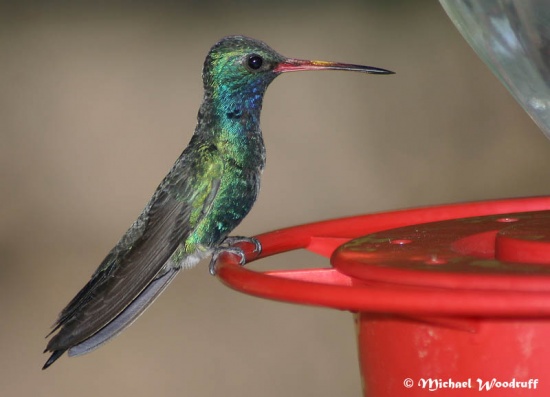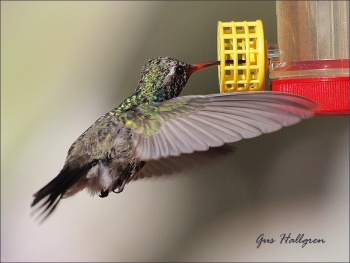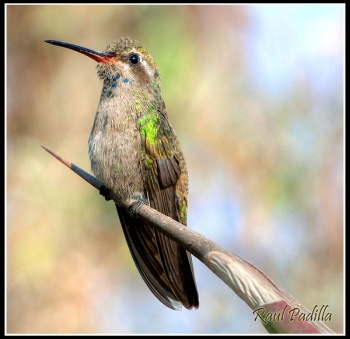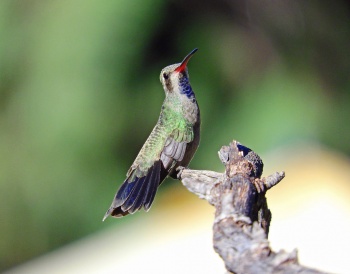- Cynanthus latirostris
Includes Doubleday's Hummingbird
Identification
9-10cm (3½-4 in)
Male
- Metallic green upperparts and breast
- White undertail coverts
- Deep blue throat
- Dark, slightly forked tail
- Black-tipped slender red bill
Female: less colourful, white eye stripe
Variations
- C. l. doubledayi: dark blue-black undertail-coverts, blue forehead and longer more deeply forked tail
- C. l. lawrencei has a green throat
Distribution
Southwestern United States to southern Mexico and Tres Marias Islands.
Accidental vagrant to Kansas.
Taxonomy
Subspecies
There are 5 subspecies[1]:
- C. l. magicus:
- C. l. latirostris:
- Eastern Mexico (San Luis Potosí and Tamaulipas to northern Veracruz)
- C. l. propinquus:
- Central Mexico (Guanajuato to Michoacán)
- C. l. doubledayi: (Doubleday's):
- Southern Mexico (Guerrero, Oaxaca and Chiapas)
- C. l. lawrencei:
- Tres Marías Islands (off western Mexico)
Some authorities3,4 split Doubleday's Hummingbird Cynanthus doubledayi from this taxon and others1,2 retain it as a subspecies of Cynanthus latirostris.
Habitat
Lower riparian woods, forested mountains (observed to 5500 feet), high desert, oak and Alligator pine, orange groves. Visits backyard feeders.
Behaviour
When perched, the male quivers his tail. often whilst calling.
Breeding
The female builds the nest in a tree or shrub. The clutch consists of 2 white eggs.
Diet
The diet includes nectar and insects.
Vocalisation
Call: They have a loud chittering call which is similar to the call of a Ruby-crowned Kinglet, but more emphatic and without the pauses in the phrasing of the kinglet.
References
- Clements, J. F., T. S. Schulenberg, M. J. Iliff, D. Roberson, T. A. Fredericks, B. L. Sullivan, and C. L. Wood. 2017. The eBird/Clements checklist of birds of the world: v2017, with updates to August 2017. Downloaded from http://www.birds.cornell.edu/clementschecklist/download/
- Dickinson, EC, ed. 2014. The Howard and Moore Complete Checklist of the Birds of the World. 4th ed. Princeton: Princeton Univ. Press. ISBN 978-0956861122
- Gill, F and M Wright. 2008. Birds of the World: Recommended English Names. Princeton University Press, Princeton NJ, USA. 2006. ISBN 9780691128276. Update (2008) downloaded from http://worldbirdnames.org/names.html.
- Sibley, CG and BL Monroe. 1996. Birds of the World, on diskette, Windows version 2.0. Charles G. Sibley, Santa Rosa, CA, USA.
- BF Member observations
- Wikipedia
Recommended Citation
- BirdForum Opus contributors. (2024) Broad-billed Hummingbird. In: BirdForum, the forum for wild birds and birding. Retrieved 27 April 2024 from https://www.birdforum.net/opus/Broad-billed_Hummingbird







